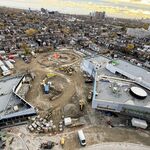Uh, no. TGV trains are long distance, high speed trains. Toronto-Montreal would be a SNCF TGV market, not a GO market.
You might be thinking of TER - Transport express régional, which are electric, conventional, often bilevel trains that's part of the SNCF network and often funded by and operated for regional governments. When I went to Chartres from Paris, I took a TER Centre train.
Actually:
What I was thinking of a scenario whereupon electrified RER extended to Kitchener is the allday allstop service, and the high speed GO trains is what replaces the diesel expresses.
You are certainly right it could feel like a GO/VIA hybrid. No dispute there. More commuter-feeling than VIA, but less-subway-feeling than GO. But possibly being an Ontario-funded Metrolinx operated service...
Instead of SmartTrack, RER, diesel GO trains, UPX, you've got
only two train services on the Kitchener corridor by the 2040s: RER and HSR. With a mostly four-tracked corridor (except small sections, like 3 tracks in certain areas) and already-solved freight bottleneck (i.e. Freight Bypass successfully proceeds, boosted by Federal -- or successful Brampton corridor widening), you've got the necessary express and allstop tracks to make allday RER+HSR service work. Things would drag and be drawn out long enough that UPX could conveniently go EOL (End-of-Life) into electric RER, and its ultimate 'express' replacement is the HSR to London (and the airport/Woodbine is just a mere stop, and not a raison d'etre -- thus mooting the white elephant factor).
Right now is certainly not the right time to introduce this yet, but in progressive densification, better transit in London/Kitchener, and on an incremental Long March perspective (With both London/Kitchener well-developed enough), it appears to make a lot of sense, IMHO. That said, I don't think HSR should extend to Windsor, as that's really way too low density.
Instead of HSR, it could very easily instead be High Performance Rail (halfway between RER and HSR). Just like many of the European commuter trains, too.
The line between HSR and HPR is somewhat blurred as the London-Kitchener-Pearson-Toronto route (with occasional less-express high performance trains also stopping at a few select extra destinations, like a once-a-day or twice-a-day Brampton stop, as a political quid pro quo in exchange for sending high speed trains through Brampton).
Given it being initially the only HSR/HPR service on a starter segment of upgraded rail -- obviously it would have to capture both the commuter market and the intercity market, to succeed initially at first. Some TGV routes are definitely very well-filled with commuters (they get crowded at peak), especially on routes that have destination distances matching the London-Kitchener-Toronto profile. The Paris-Lyon route is predominantly filled with those double-decker TGV Duplex trains at peak, filled with lots of commuters.
On certain routes for TGV, taking a catching the train during a weekday peak, it
DOES feels like a high speed GO train --
standees too! Assuming you got one of those unassigned tickets, took a peak train, with no seat assignment.
Many tourists buy first class tickets or assigned-seating tickets, sit in those nicer 3-abreast coaches, and travel offpeak; and have not witnessed TGV peak-period unassigned fare in plain 4-abreast coach seating with the aisle full of standees... This is distinctly a the feel of a GO train moment for TGV;
While GO is still very homogenous here, TGV is comparatively all over the map in Paris, with single-decker and double-decker trains, of various models, trains that feel luxurious, to peak-period commuter-optimized TGV trains that feels closer to a GO train...
Later on, when it made sense, further HSR extensions can occur instead of 401 widenings. Both incredibly expensive options, and I'd totally lean HSR or HPR sufficiently fast that a full-connection trip (transit-HSR/HPR-transit) can compete with a drive. I do see LKPT (London-Kitchener-Pearson-Toronto) HSR being more economically viable sooner than TKOM HSR (Toronto-Kingston-Ottawa-Montreal), even if as an Ottawan I'd prefer TKOM HSR.
It may not be called "high speed GO trains". But it would obviously be more commuter-optimized than VIA; and very possibly operated as a Metrolinx service. Thus, that's why I call whatever HSR/HPR occurs to London eventually funded by Ontario, calling them "High Speed GO trains", because that's the closest match of what rail-based beast it really is.
For now, that's my placeholder name, "High Speed GO trains" -- because too many Canadians thinks HSR is probably a VIA-only service towards Ottawa and "something you take instead of an airplane" -- when HSR needs a larger commuter contingent to be worth the while.
I'm
really talking from a "Long March" perspective -- one-plus generation away -- given appropriate densification, EOL-ing of existing services (UPX), and appropriate transit improvements within corridor cities.
The corridor, transit-improvement, intensification, and political pressure seems already aligned in this direction - for HSR/HPR to occur in the Kitchen corridor to happen approximately one generation away (2015->2035ish).
Based on your prior posts here, my belief is we're practically in mostly agreement here, with the exception of semantics and details (whether they are called as "High Speed GO trains" or not, funding priorities, timing, "HSR" versus "HPR", etc). Right?
Obviously, not mutually exclusive with VIA and Metrolinx services running on the same corridor, but it is very possible that an Ontario-operated HSR (defacto Metrolinx/defacto high speed GO trains, perhaps under a new brand) could happen before VIA-operated HSR, depending on how politics go...





